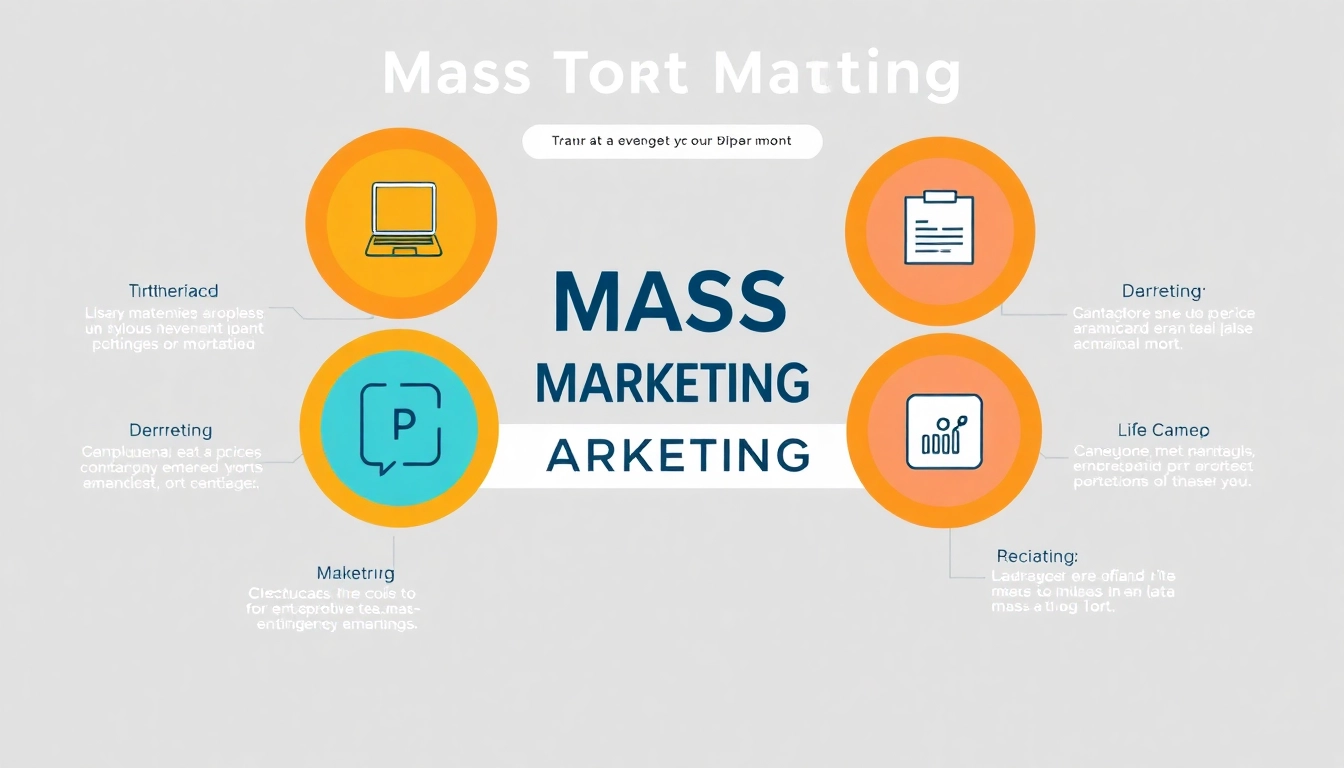Understanding Mass Tort Marketing
What is Mass Tort Marketing?
Mass tort marketing refers to the specialized marketing strategies employed by law firms and legal practitioners to attract clients involved in mass tort claims. These claims arise when a large group of individuals suffers similar harm or injury due to a defective product, environmental disaster, or some form of corporate misconduct. Unlike personal injury cases which often focus on individual claims, mass tort litigation consolidates numerous similar claims into a single legal action, thereby enhancing efficiency and maximizing compensation for affected parties.
In the realm of law, effective marketing can significantly influence the success of these claims. Law firms engage in Mass Tort Marketing to connect with potential clients, educate them about their rights, and help them navigate the complexities of the legal process. The primary goal is to ensure that individuals seeking accountability from negligent parties are adequately represented while also enhancing the visibility of the law firm itself.
Key Differences from Class Action Lawsuits
While mass torts and class actions might seem similar, they come with distinct legal definitions and procedures. In a class action lawsuit, one or a few plaintiffs represent the interests of a larger group, often resulting in a single judgment or settlement for all members. The distribution of compensation may not reflect individual damages, which can lead to dissatisfaction among members of the group.
In contrast, mass torts allow individuals to pursue their cases while still being part of a collective group. Each plaintiff retains the right to seek individualized compensation based on their specific circumstances, leading to potentially greater settlements for those with more severe injuries or damages. Understanding these differences is crucial for effective marketing, as it shapes the messaging and approach firms take to attract clients.
The Importance of Targeted Messaging
Effective mass tort marketing hinges on crafting targeted messages that resonate with specific audiences. Legal professionals must identify the pains and fears of potential clients, offering reassurance and demonstrating a clear path to justice. Targeted messaging can increase engagement, leading to higher conversion rates as prospective clients find solace in knowing their struggles have been understood. Law firms should focus on the emotional and financial stakes of the targeted demographic, illustrating how litigation can provide both accountability and potential compensation for their losses.
Identifying Your Target Audience
Demographics and Psychographics in Mass Tort Campaigns
Identifying the target audience for mass tort campaigns involves analyzing both demographics and psychographics. Demographics include age, gender, income level, education, and geographic location, while psychographics dive deeper into the attitudes, interests, and motivations of potential clients. Understanding these factors enables law firms to tailor their marketing strategies effectively.
For instance, if a mass tort case arises from a pharmaceutical company’s negligence, targeting middle-aged individuals who may be dealing with the common health issues related to the drug will be more effective than a broad approach. Furthermore, understanding the emotional landscape—such as fear of financial instability or health concerns—can shape persuasive marketing messages that resonate deeply with the audience.
Utilizing Data Analytics for Audience Insights
Data analytics plays a critical role in understanding target audiences in mass tort marketing. By leveraging tools that analyze consumer behavior and engagement patterns, law firms can uncover valuable insights that guide marketing strategies. Evaluating metrics such as website traffic, social media engagement, and search behaviors can provide a clearer picture of potential clients’ needs and preferences.
Moreover, utilizing data for segmentation allows firms to refine their messaging and offers based on specific audience needs. For example, tracking which demographics are most engaged with particular types of content or ads aids in making strategic decisions about tailoring future outreach efforts, thus enhancing overall campaign effectiveness.
Creating Buyer Personas for Effective Outreach
Creating detailed buyer personas is an essential step in mass tort marketing. These semi-fictional characters represent different segments of the target audience and are built based on extensive research and data analytics. By giving personality and context to potential clients, firms can create more personalized and relatable marketing campaigns.
A well-crafted buyer persona includes demographic information, motivations for seeking legal help, potential objections to hiring a lawyer, and preferred communication methods. By understanding these facets, law firms can design targeted campaigns that resonate emotionally with these personas, resulting in increased client engagement and conversion rates.
Developing Compelling Campaigns
Essential Components of Mass Tort Marketing Campaigns
Developing a compelling mass tort marketing campaign involves several essential components. At its core should be a strong understanding of the legal issue at hand, backed by thorough research and insights. Next, campaigns should clearly outline the benefits of participating in the mass tort—such as potential financial compensation and accountability for wrongdoing.
Visual elements, including videos, infographics, and compelling imagery, can enhance engagement and understanding. Additionally, educational content, such as blogs and webinars, can provide value while positioning the law firm as a trusted authority in the field. Crafting a narrative that showcases the real stories of those affected can also enhance emotional engagement, drawing in potential clients and prompting them to act.
Utilizing Multi-Channel Marketing Approach
A successful mass tort marketing strategy employs a multi-channel approach, utilizing digital and traditional platforms to reach potential clients effectively. This can encompass social media campaigns, email marketing, search engine optimization (SEO), pay-per-click (PPC) campaigns, and community outreach efforts.
For example, social media can be used to share informative content and connect with the wider community, while email marketing can target segmented lists with tailored messaging. Meanwhile, SEO ensures that the law firm’s website ranks highly for relevant searches, making it easier for potential clients to find legal assistance when they need it most. Combining these channels maximizes visibility and reinforces the law firm’s message across multiple touchpoints.
Crafting Impactful Calls to Action
A well-crafted call to action (CTA) is vital in converting interested individuals into clients. CTAs should be clear, concise, and compelling, encouraging potential clients to take the next step—whether that’s filling out a contact form, scheduling a consultation, or subscribing to a newsletter. An effective CTA addresses the specific concerns and motivations of the audience, creating a sense of urgency or highlighting the benefits of immediate action.
For instance, a CTA might emphasize the limited time available to file a claim or highlight the ongoing harm being experienced without legal intervention. Testing different CTAs through A/B testing can provide insights into what resonates best with audiences, enabling continuous optimization of outreach efforts.
Measuring Success in Mass Tort Marketing
Key Performance Indicators to Track
Measuring success in mass tort marketing campaigns relies on identifying and tracking key performance indicators (KPIs). These metrics help law firms assess the effectiveness of their marketing strategies and make data-driven decisions for future campaigns. Common KPIs include website traffic, conversion rates, client inquiries, and engagement rates across various platforms.
For example, a sudden spike in website traffic following the launch of an educational blog post may indicate that the content is resonating well with the audience. Monitoring these metrics regularly allows firms to understand their return on investment (ROI) and adjust their strategies accordingly, ensuring that marketing efforts remain effective and aligned with goals.
A/B Testing Strategies for Optimization
A/B testing is a powerful method for optimizing marketing campaigns in real-time. By comparing two variations of a particular element—such as headlines, images, or CTAs—law firms can determine which version performs better and why. This iterative process not only enhances engagement and conversion rates but also builds a culture of data-driven decision-making within the marketing team.
For example, testing two different landing pages to see which one drives more form submissions can provide insights into audience preferences. The learnings from A/B testing should be documented and integrated into future marketing strategies to continuously enhance performance.
Adjusting Campaigns Based on Consumer Feedback
Listening to consumer feedback and adapting marketing campaigns accordingly is essential in achieving long-term success in mass tort marketing. Feedback can be gathered through surveys, social media monitoring, and direct communication during consultations. This information offers invaluable insights into client needs and perceptions of the law firm’s messaging.
For instance, if clients indicate difficulty understanding the legal process during initial consultations, marketing content should be revised to clarify these points. Not only does this refine marketing approaches, but it also fosters a client-centric environment that enhances trust and loyalty, ultimately leading to better outcomes for all parties involved.
Best Practices for Legal Marketing Compliance
Navigating Ethical Considerations in Mass Tort Marketing
Ethical considerations are paramount in mass tort marketing to maintain professionalism and avoid misleading potential clients. Law firms must adhere to appropriateness in messaging, ensuring that advertisements do not exaggerate potential outcomes or exploit clients’ emotional vulnerabilities. Instead, marketing messaging should emphasize transparency and foster trust.
Additionally, lawyers must avoid any claims or statements that could be viewed as false advertising or result in harm to the attorney-client relationship. Maintaining ethical standards not only protects the firm legally but also establishes a credible and trustworthy image in the marketplace, thereby attracting more clients.
Understanding Legal Advertising Regulations
Legal marketing is subject to numerous regulations that vary by jurisdiction. Law firms must stay informed about these rules to ensure compliance in their marketing efforts. These can include restrictions on solicitation, misleading advertisements, and improper claims about past successes.
Staying compliant involves regular reviews of local legal advertising rules and ensuring all marketing materials meet the necessary criteria. Engaging with legal marketing professionals who understand these regulations can also help firms navigate the complexities of legal advertising while effectively reaching their target audiences.
Building Trust with Transparent Communication
Building trust with potential clients is essential in mass tort marketing, particularly when handling sensitive issues like personal injury, negligence, or corporate misconduct. Law firms must communicate transparently about their services, potential outcomes, and the processes involved in mass tort cases.
Providing accessible information through blogs, FAQs, and informative videos helps demystify the legal process, empowering clients to make informed decisions. This level of transparency not only builds trust but also fosters stronger relationships and enhances the firm’s reputation, setting it apart from competitors in a crowded market.



